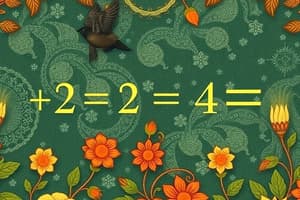Podcast
Questions and Answers
What is the nominal interest rate?
What is the nominal interest rate?
- The rate of return on debt instruments
- The interest rate adjusted for inflation
- The interest rate not adjusted for inflation (correct)
- The true cost of borrowing
According to the Fisher equation, how is the real interest rate related to the nominal interest rate and expected inflation rate?
According to the Fisher equation, how is the real interest rate related to the nominal interest rate and expected inflation rate?
- Real interest rate = Nominal interest rate * Expected inflation rate
- Real interest rate = Nominal interest rate - Expected inflation rate (correct)
- Real interest rate = Nominal interest rate / Expected inflation rate
- Real interest rate = Nominal interest rate + Expected inflation rate
Why is the real interest rate considered more important for economic decisions?
Why is the real interest rate considered more important for economic decisions?
- Because it represents the rate of return on debt instruments
- Because it is adjusted for inflation
- Because it reflects the true cost of borrowing (correct)
- Because it fluctuates less compared to nominal interest rate
In the context of debt instruments, what are cash flows?
In the context of debt instruments, what are cash flows?
What does the Fisher equation state about the relationship between nominal and real interest rates?
What does the Fisher equation state about the relationship between nominal and real interest rates?
What is the principal in the context of a simple debt instrument like a loan?
What is the principal in the context of a simple debt instrument like a loan?
What is the formula to calculate the future value of a loan after one year?
What is the formula to calculate the future value of a loan after one year?
What does 'discounting the future' refer to?
What does 'discounting the future' refer to?
What is the yield to maturity on a loan if $100 is borrowed and the borrower has to pay back $110 after one year?
What is the yield to maturity on a loan if $100 is borrowed and the borrower has to pay back $110 after one year?
What is the concept that allows comparison of values of different market instruments with varying timing of their payments?
What is the concept that allows comparison of values of different market instruments with varying timing of their payments?
If you lend $100 for two years at a 10% interest rate, what will be the future value of your loan?
If you lend $100 for two years at a 10% interest rate, what will be the future value of your loan?
What does the formula PV= FV / (1+i)^n represent?
What does the formula PV= FV / (1+i)^n represent?
What does 'simple-interest rate' refer to in the context of loan calculation?
What does 'simple-interest rate' refer to in the context of loan calculation?
What does calculating 'the simple-interest rate' involve?
What does calculating 'the simple-interest rate' involve?
Flashcards are hidden until you start studying
Study Notes
Interest Rates and Debt Instruments
- The nominal interest rate is the rate of interest before adjusting for inflation.
- The Fisher equation states that the real interest rate is equal to the nominal interest rate minus the expected inflation rate.
- The real interest rate is considered more important for economic decisions because it reflects the true purchasing power of the borrower.
Debt Instruments and Cash Flows
- Cash flows refer to the stream of payments made over time in a debt instrument, such as a loan or bond.
- In a simple debt instrument like a loan, the principal is the initial amount borrowed.
Calculating Future Value and Yield to Maturity
- The formula to calculate the future value of a loan after one year is FV = PV x (1 + i), where FV is the future value, PV is the present value, and i is the interest rate.
- The yield to maturity on a loan is the total return on investment, considering the interest rate and the timing of payments.
- In the example where $100 is borrowed and the borrower has to pay back $110 after one year, the yield to maturity is 10%.
Discounting the Future and Present Value
- Discounting the future refers to the concept of reducing the value of future cash flows to their present value, taking into account the time value of money.
- The formula PV = FV / (1 + i)^n represents the present value of a future cash flow, where PV is the present value, FV is the future value, i is the interest rate, and n is the number of periods.
Simple Interest Rate and Loan Calculation
- The simple-interest rate refers to the interest rate charged on the initial principal amount of a loan.
- Calculating the simple-interest rate involves multiplying the principal amount by the interest rate to determine the interest paid over a period.
Studying That Suits You
Use AI to generate personalized quizzes and flashcards to suit your learning preferences.




